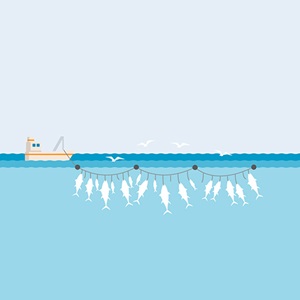What is pole and line fishing, and how can this method be used sustainably?
What is pole and line fishing?
Pole and line fishing uses a wooden or fibreglass hand-held pole attached to fishing line and is used to catch fish one at a time. This gear type is typically used to target smaller tuna species, such as skipjack and albacore, and is responsible for 7% of the global tuna catch.

South African albacore tuna fishermen in action
Pole and line fisheries attract tuna by spraying water from the vessel and scattering small bait fish, such as sardines or anchovies, into the water. This method, known as ‘chumming’, creates the illusion of a school of fish, which brings tuna to the surface in a feeding frenzy where they bite onto hooks at the end of the fishers’ lines.
In some fisheries, once a tuna (typically albacore) is hooked it is hauled aboard by two members of the crew. In skipjack fisheries, the pole is flicked up and over the head of the fisher to land the tuna on deck.
This method of fishing can be used to target tuna that congregate around fish-aggregating devices (FADs) or free-swimming schools.
Is pole and line fishing sustainable?
Pole and line fishing is a highly selective method where fish are caught one at a time close to the surface of the ocean. As a result, there are low levels of bycatch and the gear does not come into contact with seabed habitats.
To meet the MSC’s Standard for sustainable fishing, fisheries using pole and line gear must also consider the wider impacts of their activities on the marine environment and fish stocks.
Under the MSC Fisheries Standard Version 3, fisheries that use FADs must also account for any lost FADs and demonstrate how they are avoiding and managing this loss. This includes tracking or retrieving FADs or using non-entangling and biodegradable FADs.
How does MSC certification drive improvements?
The Maldives pole and line skipjack tuna fishery was first certified in 2012 but was required to make further improvements as a condition of its certification. This included providing evidence to demonstrate the fishery’s impact on bait fish stocks and to develop a plan to manage these stocks sustainably. To achieve this, data was gathered on bait catch volumes, different species and locations. The fishers also recorded interactions with endangered species that occurred during bait fishing operations.
Maldives skipjack tuna: a sustainability success story
In August 2024, the South Africa albacore tuna pole and line fishery became the first to achieve MSC certification following participation in the In-Transition to MSC program (now the MSC Improvement Program).
Although on-board observers reported minimal interactions with endangered, threatened and protected (ETP) species and fishers were trained to safely handle and release bycatch, the fishery is still required to gather more data on interactions with ETP species. This will enable the fishery to demonstrate impacts on ETP species with greater precision and help shape a management strategy.




